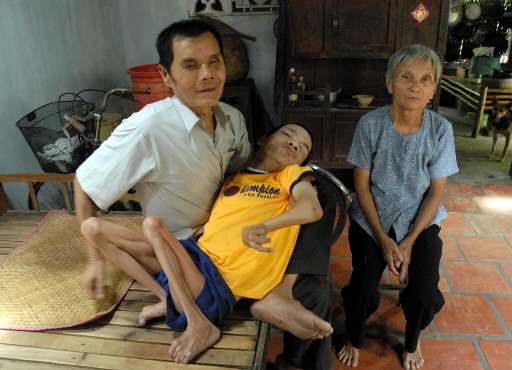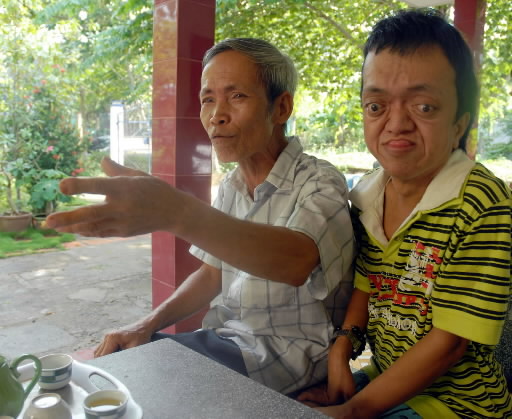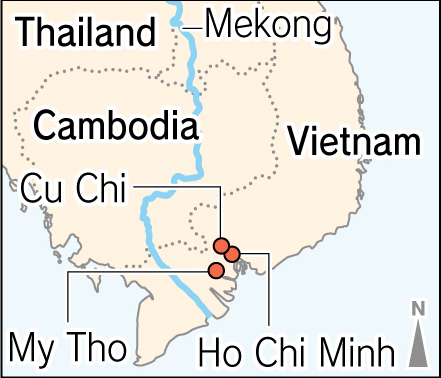Vietnam: 50 years after the use of defoliants, Part 1: Walking the affected areas, Article 2
Jul. 6, 2012
Article 2: After the fighting
Children of former soldier severely disabled
by Takahasa Kyoren, Staff Writer
Worries for future: “I feel miserable”
In Cu Chi, 30 km northwest of downtown Ho Chi Minh City, a water buffalo tilled a paddy field before the advent of the rainy season.
This rural Mekong Delta town served as a base for the National Front for the Liberation of South Vietnam (Viet Cong) during the war. The Cu Chi tunnels, a 200-km network of connecting tunnels dug below the forest, served as an underground base for the Viet Cong that included an operations room. The U.S. military dropped defoliant and fire bombs on the tunnels, which are now a popular destination for foreign tourists.
I visited the home of Le Thanh Can, 70, a former soldier in the Viet Cong. His spindly son Le Van Loi, 34, lay on a bed in a corner of the kitchen. Loi was born completely paralyzed and has brain damage. His brother Le Thanh Hai, 31, also has brain damage. Last November the three of them were certified by the government as victims of defoliants.
No care provided after the war
“I’m getting old. Dressing and feeding them, changing their diapers – it’s hard,” said Mr. Le’s wife, Vo Thi Em, 67, as she brought a spoon to Loi’s mouth.
In 2008 the brothers were examined by a team of doctors from Japan that visited Vietnam to provide medical assistance, but nothing could be done for them. No other care had been provided since the war. Since being certified as victims of defoliants, the government has provided Mr. Le and his sons with total monthly assistance of about 3 million dong (approximately 150 dollars).
From 1968 to 1969 Mr. Le was involved in the fighting in Cu Chi. While the U.S. military considered pulling out of Vietnam, its use of defoliants on the front lines intensified. In 1969, 13 million liters of highly toxic Agent Orange were sprayed over South Vietnam, the largest amount used during the war. One day Mr. Le was bathed in defoliant and lost the sight in his right eye. He became completely blind as a result of a bomb that hit after that.
Of his wife’s five pregnancies after he returned home following the war, one ended in a miscarriage and another child was stillborn. His other three children were all born with handicaps, and one died after only one month. “It was only later that I found out it was on account of the effects of the war,” said Mr. Le. “I feel miserable.”
According to the Cu Chi Association for Victims of Agent Orange/Dioxin, there are 650 victims of defoliants in the area, most second- or third-generation victims. Only 238 of them, however, have received government certification. In many cases the victims are deterred by the long wait for certification after applying or can not produce evidence that they were in a contaminated area.
When I was leaving his house, Mr. Le was humming a tune: “I spilled my blood for my country; my wife worked hard growing rice.”
Both the Ho Chi Minh Trail, the supply route for the Viet Cong which ran from North Vietnam along the border with Laos to the Cu Chi area, and the Mekong Delta in southernmost Vietnam, the site of resistance by the Viet Cong, were attacked relentlessly by U.S. forces. The villages in the surrounding areas were caught up in the fighting.
“Don’t drink the water”
In 1970, Do Xuan Tuan, 62, who lives in My Tho in the Mekong Delta, traveled from Hanoi to the Mekong Delta via the Ho Chi Minh Trail to engage in raids. At the site of every battle he was told not to drink the water. His fourth son, Do Quoc Thanh, 29, who was born after the war, has hydrocephaly. Thanh has remained at home since graduating from a primary school for the handicapped.
Mr. Do suffers from a nervous system disorder, and he and his son receive monthly assistance of about 2.2 million dong (approximately 110 dollars). “I don’t know whether I was poisoned by dioxin on the battlefield or my wife ingested it. But it is certain that my wife and I bear responsibility for Thanh’s life,” he said. “The U.S. government has not provided any compensation to the Vietnamese people or demonstrated even the slightest sense of responsibility.” Residents of the areas where fierce fighting once took place are filled with frustration and anxiety.
Spraying of defoliants by the U.S. military in the Cu Chi area
Approximately 37 million liters of defoliants, 45 percent of the total amount used from 1961 to 1971, were sprayed over the Third Military District. This area included Cu Chi and War Zone C along the Cambodian border and constituted about one-sixth of the total area of South Vietnam.
(Originally published on June 20, 2012)










